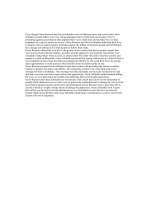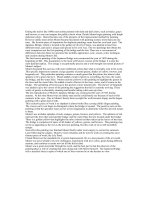claude oscar monet
Bạn đang xem bản rút gọn của tài liệu. Xem và tải ngay bản đầy đủ của tài liệu tại đây (33.95 KB, 1 trang )
Short essay about the painter Good, very descriptive, well put together
The most famous of the impressionist painters, Claude Oscar Monet, born, November 14, 1840
and died. December 5, 1926, was also the most committed to recording the effects of light and
atmosphere on art work. This idea led Monet and his colleagues to develop the techniques of
impressionism Monet advised his fellow painters to concentrate on the play of light and color of
the objects that they had before them. The goal was to capture temporary phenomena, and this
was pursued in a systematic manner, according to the laws of optics and complementary color
relationships; yet the result was often a sheer celebration of painting itself, an expression of
Monet's delight in the colors, textures, and shapes of the landscape.
In 1859, Monet moved to Paris and attended the Academie Suisse, where he met Camille Pissarro.
After a break for military service and a brief return to Le Havre, he returned to Paris to enroll in
the studio of Charles Gleyre, where he met Pierre Auguste Renoir, Frederic Bazille, and Alfred
Sisley. By 1865 he had embarked on a program of outdoor painting of marine and forest subjects,
townscapes, and figures in landscape settings.
In the summer of 1869, Monet worked alongside Renoir and began to emerge as the leading figure
in the creation of the techniques of outdoor impressionism.
Until the 1880s, Monet endured extreme poverty, during this decade, his works began to sell at
higher prices, allowing him to live and paint as he wished. In the early 1890s, he again took up
the idea of producing a series of views of the same subject which he intended to be shown as a
group. His subjects included haystacks, poplars, the facade of Rouen Cathedral as it altered from
dawn to dusk, the Seine at Giverny, and views of the Thames and the Houses of Parliament. But
Monet's key subject after 1890 was the lily pond he had built at his home in Giverny. These now
hang in the Museum of Modern Art, New York City, and in the Musee de l'Orangerie, Paris. Sky,
water, and vegetation are transformed into swirling, vibrant masses of color, Claude Monet used
every element of color to transform his art into a pieces of beauty.
Bibliography: Isaacson, Joel, Claude Monet (1978); Joyes, Claire, Monet at Giverny (1976);









